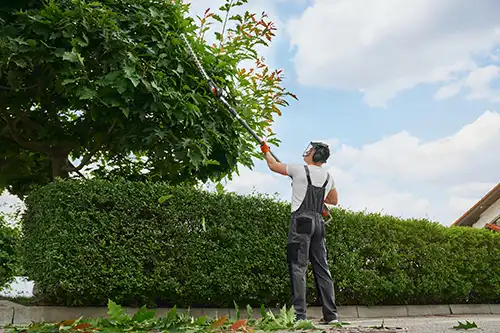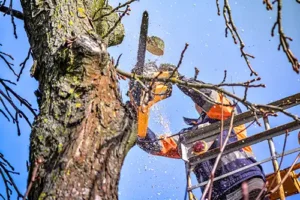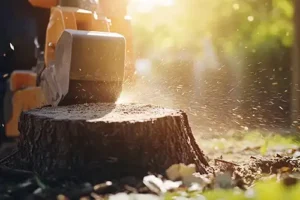Trees are an essential part of any landscape, providing shade, beauty, and environmental benefits. However, to ensure their long-term health and structural integrity, proper pruning is necessary. Tree pruning is more than just cutting off branches; it is a strategic process that promotes growth, enhances tree shape, and prevents potential hazards. At Madcow Tree Service, we use a variety of pruning techniques tailored to each tree’s needs, ensuring optimal health and longevity. In this blog, we will compare different tree pruning methods and their benefits for long-term growth.
Thinning vs. Reduction Pruning
Thinning and reduction pruning are two techniques used to manage tree growth and improve structural integrity. The thinning technique involves selectively removing branches throughout the canopy to allow more sunlight and air circulation. This method is particularly beneficial for dense trees that may suffer from interior dieback due to a lack of light. Reduction pruning, on the other hand, is used to decrease the overall size of a tree by shortening branches while maintaining its natural shape. This technique is useful when trees encroach on structures or power lines, preventing potential damage while preserving the tree’s health. While both methods improve tree structure, thinning promotes internal health, whereas reduction pruning controls external growth.
Deadwood Removal vs. Crown Cleaning
To improve tree safety and health, deadwood removal and crown cleaning focus on eliminating unhealthy or hazardous branches. Deadwood removal is the process of cutting away dead or dying branches that can become a hazard during storms or high winds. This practice not only prevents falling limbs but also reduces the spread of decay and disease within the tree. Crown cleaning, a more comprehensive approach, involves the removal of dead, broken, or weak branches throughout the tree’s canopy. This technique enhances the tree’s appearance and overall health by reducing stress on the remaining limbs. While both methods focus on improving tree safety, crown cleaning provides a more thorough approach to tree maintenance.
Structural Pruning vs. Directional Pruning
Structural pruning and directional pruning are critical for young trees because they help shape future growth patterns. The process, structural pruning, involves selectively removing branches to establish a strong central leader and a well-balanced branch structure. This technique is especially important for young trees to prevent weak limb attachments that could lead to breakage as the tree matures. Directional pruning, however, focuses on guiding tree growth by removing or shortening branches that grow in undesirable directions, such as toward buildings, power lines, or walkways. By implementing these pruning techniques early, homeowners can encourage stable, healthy growth and prevent structural issues later in the tree’s life.
Crown Raising vs. Crown Reduction
Crown raising and crown reduction serve different purposes, yet both support the long-term health of a tree. The process of crown raising removes lower branches to provide clearance for pedestrians, vehicles, or buildings. This technique is commonly used in urban and suburban areas to maintain accessibility while preserving the tree’s natural form. Crown reduction, in contrast, reduces the overall height and spread of a tree by cutting back specific branches, often in response to storm damage or structural weaknesses. While crown raising improves usability and aesthetics, crown reduction is essential for maintaining the tree’s health and preventing excessive weight on weak limbs.
Espalier Pruning vs. Pollarding
Espalier pruning and pollarding are specialized techniques used to achieve specific landscape goals. In espalier pruning, trees are trained to grow flat against a structure like a wall or trellis by carefully cutting and shaping their branches. This method is often used for decorative purposes in gardens and orchards. Pollarding, on the other hand, is a more aggressive pruning method that involves cutting back all branches to a predetermined height, encouraging the growth of a dense canopy of new shoots. Pollarding is commonly used for trees in urban settings to control their size and prevent interference with utilities. While espalier pruning is ideal for aesthetic appeal, pollarding is a practical solution for managing tree growth in confined spaces.
The Importance of Professional Tree Pruning Services
Pruning is both an art and a science, requiring knowledge of tree biology and proper cutting techniques. Incorrect pruning can lead to irreversible damage, weak structures, or increased susceptibility to disease. Hiring a professional tree care service like Madcow Tree Service ensures that trees are pruned using the best techniques suited to their species, growth patterns, and environmental conditions. Our team has the experience and equipment to perform precise pruning that enhances tree health while maintaining safety on your property. Contact us today to invest in quality tree care.
Rely on Madcow Tree Service for Top-Quality Results
Proper tree pruning is essential for maintaining the health, appearance, and safety of trees on residential properties. By understanding and applying the right pruning techniques, homeowners can encourage strong growth, prevent potential hazards, and extend the lifespan of their trees. Whether your tree needs thinning, crown reduction, structural pruning, or specialized techniques like pollarding, Madcow Tree Service has the expertise to provide high-quality care. Call 618.288.9663 for professional tree trimming, pruning, health care, removal, and more. With over 50 years of combined experience, we are committed to keeping your trees healthy and your property safe.







